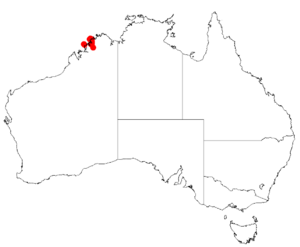Acacia kenneallyi facts for kids
Quick facts for kids Acacia kenneallyi |
|
|---|---|
| Conservation status | |
| Scientific classification | |
| Genus: |
Acacia
|
| Species: |
kenneallyi
|
 |
|
| Occurrence data from AVH | |
Acacia kenneallyi is a special type of shrub or small tree. It belongs to the Acacia family, which is also known as the wattle family. This plant is endemic, meaning it's found only in the northwest part of Australia and nowhere else in the world.
Contents
What Does Acacia kenneallyi Look Like?
This unique shrub or tree usually grows to be about 2 to 7 meters (6.5 to 23 feet) tall. Its branches are smooth and round, often covered with a fine white powder.
Leaves and Flowers
Like many Acacia species, Acacia kenneallyi doesn't have typical leaves. Instead, it has flat, leaf-like structures called phyllodes. These phyllodes are tough and stay green all year round. They are long and narrow, measuring about 15 to 25 centimeters (6 to 10 inches) long and 6 to 14 millimeters (0.2 to 0.5 inches) wide. Each phyllode has one clear main vein running down the middle.
The plant blooms from May to June, showing off bright yellow flowers. These flowers grow in round clusters, called inflorescences, which are about 5 millimeters (0.2 inches) across. Each cluster is packed with 46 to 56 golden-colored flowers.
Seed Pods
After the flowers, the plant forms long, flat seed pods. These pods are tough and can grow up to 11 centimeters (4.3 inches) long and 10 to 11 millimeters (0.4 inches) wide. They hold the seeds for the next generation of plants.
How Is Acacia kenneallyi Related to Other Plants?
Acacia kenneallyi is closely related to a few other Acacia species. These include Acacia spectra, Acacia latescens, and Acacia orthotropica. Even if they look a bit different, they share common ancestors.
Where Does Acacia kenneallyi Grow?
This plant is native to the Kimberley region in Western Australia. It often grows in areas with sandstone or dolerite rocks. You'll find it in thin, sandy soils.
It's mostly found on the Bonaparte Archipelago and nearby parts of the mainland. It also grows on islands like Heywood Island and Bigge Island. Here, it's part of larger plant communities, often growing alongside Eucalyptus trees.


